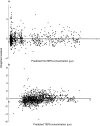Population pharmacokinetics of thioTEPA and its active metabolite TEPA in patients undergoing high-dose chemotherapy
- PMID: 11167666
- PMCID: PMC2014425
- DOI: 10.1046/j.1365-2125.2001.01301.x
Population pharmacokinetics of thioTEPA and its active metabolite TEPA in patients undergoing high-dose chemotherapy
Abstract
Aims: To study the population pharmacokinetics of thioTEPA and its main metabolite TEPA in patients receiving high-dose chemotherapy consisting of thioTEPA (80-120 mg x m(-2) x day(-1)), cyclophosphamide (1000-1500 mg x m(-2) x day(-1)) and carboplatin (265-400 mg x m(-2) x day(-1)) for 4 days.
Methods: ThioTEPA and TEPA kinetic data were processed with a two-compartment model using the nonlinear mixed effect modelling program NONMEM. Interindividual variability (IIV), interoccasion variability (IOV) and residual variability in the pharmacokinetics were estimated. The influence of patient characteristics on the pharmacokinetics was also determined.
Results: A total number of 40 patients receiving 65 courses of chemotherapy was included. Clearance of thioTEPA (CL) was 34 l x h(-1) with an IIV and IOV of 18 and 11%, respectively. The volume of distribution of thioTEPA was 47 l (IIV = 7.5%; IOV = 19%). The fraction of thioTEPA converted to TEPA divided by the volume of distribution of TEPA was 0.030 l-1 (IIV = 39%; IOV = 32%) and the elimination rate constant of TEPA was 0.64 h(-1) (IIV = 27%; IOV = 32%). CL of thioTEPA was correlated with alkaline phosphatase and serum albumin. The volume of distribution of thioTEPA and the elimination rate constant of TEPA were correlated with total protein levels and body weight, respectively.
Conclusions: A model for the description of the pharmacokinetics of thioTEPA and TEPA was developed. Factors involved in the interpatient variability of thioTEPA and TEPA pharmacokinetics were identified. Since, IOV of both thioTEPA and TEPA was equal to or smaller than IIV, therapeutic drug monitoring based on data of previous courses may be meaningful using this population model.
Figures




Similar articles
-
Polymorphisms of drug-metabolizing enzymes (GST, CYP2B6 and CYP3A) affect the pharmacokinetics of thiotepa and tepa.Br J Clin Pharmacol. 2009 Jan;67(1):50-60. doi: 10.1111/j.1365-2125.2008.03321.x. Epub 2008 Nov 17. Br J Clin Pharmacol. 2009. PMID: 19076156 Free PMC article.
-
Validation of a therapeutic drug monitoring strategy for thiotepa in a high-dose chemotherapy regimen.Ther Drug Monit. 2001 Dec;23(6):650-7. doi: 10.1097/00007691-200112000-00010. Ther Drug Monit. 2001. PMID: 11802099
-
Population pharmacokinetics of cyclophosphamide and its metabolites 4-hydroxycyclophosphamide, 2-dechloroethylcyclophosphamide, and phosphoramide mustard in a high-dose combination with Thiotepa and Carboplatin.Ther Drug Monit. 2005 Dec;27(6):756-65. doi: 10.1097/01.ftd.0000177224.19294.92. Ther Drug Monit. 2005. PMID: 16306851 Clinical Trial.
-
Pharmacological considerations of primary alkylators.Cancer Treat Res. 2002;112:323-45. doi: 10.1007/978-1-4615-1173-1_16. Cancer Treat Res. 2002. PMID: 12481723 Review. No abstract available.
-
Thiotepa.IARC Monogr Eval Carcinog Risks Hum. 1990;50:123-41. IARC Monogr Eval Carcinog Risks Hum. 1990. PMID: 2127291 Free PMC article. Review. No abstract available.
Cited by
-
Polymorphisms of drug-metabolizing enzymes (GST, CYP2B6 and CYP3A) affect the pharmacokinetics of thiotepa and tepa.Br J Clin Pharmacol. 2009 Jan;67(1):50-60. doi: 10.1111/j.1365-2125.2008.03321.x. Epub 2008 Nov 17. Br J Clin Pharmacol. 2009. PMID: 19076156 Free PMC article.
-
High-dose thiotepa-related neurotoxicity and the role of tramadol in children.BMC Cancer. 2018 Feb 13;18(1):177. doi: 10.1186/s12885-018-4090-6. BMC Cancer. 2018. PMID: 29433564 Free PMC article.
-
Sex differences in the pharmacokinetics of anticancer drugs: a systematic review.ESMO Open. 2024 Dec;9(12):104002. doi: 10.1016/j.esmoop.2024.104002. Epub 2024 Dec 10. ESMO Open. 2024. PMID: 39662226 Free PMC article.
-
Integrated Population Pharmacokinetic Model of both cyclophosphamide and thiotepa suggesting a mutual drug-drug interaction.J Pharmacokinet Pharmacodyn. 2004 Apr;31(2):135-56. doi: 10.1023/b:jopa.0000034405.03895.c2. J Pharmacokinet Pharmacodyn. 2004. PMID: 15379382
-
Pharmacokinetic-pharmacodynamic guided trial design in oncology.Invest New Drugs. 2003 May;21(2):225-41. doi: 10.1023/a:1023577514605. Invest New Drugs. 2003. PMID: 12889741 Review.
References
-
- Sykes M, Karnofsky D, Phillips F, Burchenal J. Clinical studies of triethylenethiophosphoramide and diethylenephosphoramide compounds with nitrogen mustard-like activity. Cancer. 1953;6:61–70.
-
- van der Wall E, Beijnen JH, Rodenhuis S. High-dose chemotherapy for solid tumors. Cancer Treat Rev. 1995;21:105–132. - PubMed
-
- Cole DE, Johnson G, Tartaglia RL, O'Dwyer P, Balis F, Poplack DG. Correlation between plasma pharmacokinetics and in vitro cytotoxicity of thiotepa (tt) and tepa (tp) Proc Am Ass Clin Oncol. 1989;8:72.
-
- Breau AP, Field L, Mitchell WM. Thiono compounds. 4. in vitro mutagenic and antineoplastic activity of tepa and thio-tepa. Cell Biol Toxicol. 1984;1:21–30. - PubMed
-
- Teicher BA, Waxman DJ, Holden SA, et al. Evidence for enzymatic activation and oxygen involvement in cytotoxicity and antitumor activity of N,N',N′′-triethylenethiophosphoramide. Cancer Res. 1989;49:4996–5001. - PubMed
Publication types
MeSH terms
Substances
LinkOut - more resources
Full Text Sources

